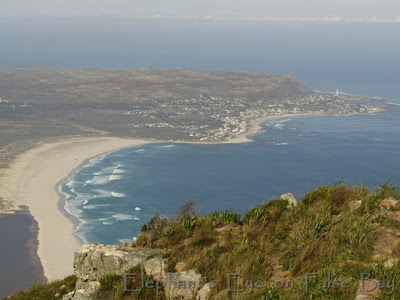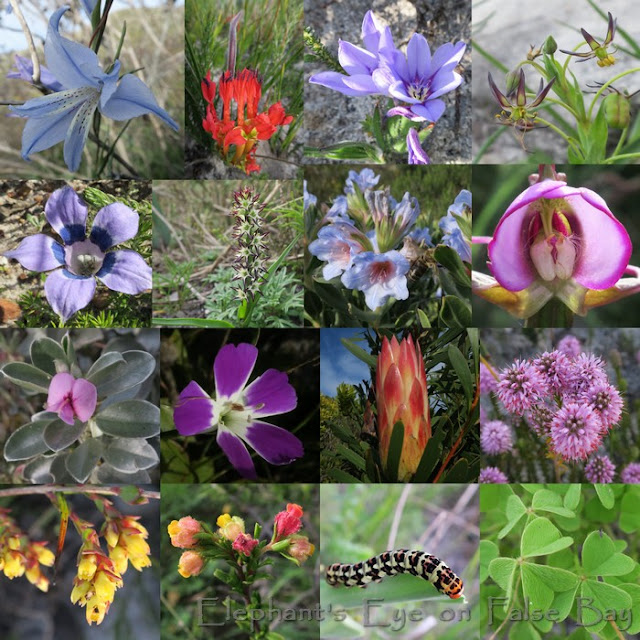July flowers from Chapman's Peak to Elsie's Peak
by Diana
Studer
- gardening for biodiversity
in Cape Town, South Africa
Hiking among
wildflowers
in the mountains
around Cape Town
From Kalk Bay Peak he looked across False Bay waves for Muizenberg
surfers. Snow dusts the tops of the distant Du Toit's Kloof mountains.
On Brakkloofrand
Yellow Cullumia setosa.
Othonna filicaulis has heart-shaped
leaves. Polyarrhena stricta (or Felicia echinata??)
White Crassula
capensis fragile flowers for a succulent. Knowltonia capensis (anemone family)
Fluffy seeds Tarchonanthus
littoralis. White Aspalathus forbesii
pea flower. Oxalis polyphylla with
thread leaves. Glowing red new leaves Cassine
peragua.
Pink Erica plukenetii
dangly bits. Flared out Erica abietina
atrorosea. Erica glabella softest
pink with burgundy stamens. Beard of Protea
lepidocarpodendron.
From Chapman's Peak his Atlantic Ocean view reaches from
Slangkop lighthouse to Hout
Bay with subsistence fisherman and affluent gated communities.
At Blackhill
Softest blue Gladiolus
gracilis. Red Babiana ringens has
a built in perch for sunbirds (which don't hover like hummingbirds). Central
white star distinguishes Babiana
villosula. Ethereal Ornithoglossum viride is the plant
for which Slangkop is named.
Second set of elaborate blue and white markings on Roella ciliata (bellflower family). Down
to Wurmbea hiemalis in burgundy and
cream (crocus family). Lobostemon
glaucophyllus (forget-me-not family) has the pink and blue flowers I love.
This time my camera caught the tiniest details within an orchid Disperis capensis.
Silver leaves and soft purple pea flowers on Podalyria sericea. Dianthus albens (more purple than white!) Dusky pink Protea repens bud will fill with nectar.
Fluffy pink Stilbe ericoides (fynbos
endemic family).
Dangling yellow Stylapterus
fruticulosus (Penaea fynbos endemic family). Red and yellow furled Hermannia rudis (Hibiscus family).
Hungry caterpillar enjoying fresh green leaves. Oxalis lanata named for its softly furred leaves (only 120 fynbos
species to learn!)
Stemless Protea
acaulos. One lonely plant bearing flowers from tight bud, to unfolding
perfection then fading.
Up on Grootkop above Camps Bay he found Anemone tenuifolia.
On Steenberg
Yellow Bolusafra
bituminosa for the tarry scented leaves (pea family). Lime gold stars of Leucadendron laureolum. A haze of Euryops abrotanifolius (leaves like
southernwood) against the sun. This one mystified me, but it is Aspalathus capitata (pea family) gone to
seed with wisps of brown petals.
Salmon Watsonia
tabularis confined to rocky sandstone slopes on the Cape Peninsula. Again
silver leaves and purple pea flowers, but Podalyia
calyptrata is a tree. Prickly Muraltia
heisteria (Polygala family). Not Felicia,
but Zyrphelis taxifolia (11 of the 13
species in the South-western Cape)
Pink pea Amphithalea
ericifolia (42 species all fynbos). Microdon
dubius (Scrophulariaceae) a dark form. Metalasia
divergens. Osmitopsis astericoides
grows in marshes.
Erica lutea with long cream tubes. Round pink 'berries' Erica
baccans. Furled white petals and chocolate stamens Erica calycina. Fluffy pink Erica
hirtiflora.
Anaxeton laeve has
startling strawberry buds opening to plain white flowers borne high on long
stalks.
Cape Mountains for Curious and Adventurous hiked UP Elsie's
Peak, Fynbos Ramblers walked for wildflowers.
Third version of blue and white markings Lobelia coronopifolia. Pink and blue Lobostemon is fruticosus. Polygala
myrtifolia with its white tassel. Nemesia
affinis with inner and outer versions of delicate purple veins.
Staavia radiata (Brunia
family) pink hearts and bright white petals. Cherry lines on Adenandra villosa (citrus! family) petals.
Thesium viridifolium (sandalwood
family) has toothed margins on white petals (an Edelweiss echo). Lemon and wine
Pelargonium triste.
Down to turquoisy Euphorbia
tuberosa. Burgundy feathering on an Oxalis
luteola bud. Muted green lines outside Moraea
collina petals. Serruria glomerata
bud.
Capelio tabularis
sturdy grey leaves rewarded us with tall and substantial yellow flowers. Protea lepidocarpodendron bearded
protea. Leucadendron salignum male
flowers.
I invite you to join us at Elephant's Eye on False Bay.
Please subscribe as you prefer
via Feedly,
or Bloglovin,
Teal blue text is my links.
To read comments if you are in email or a Reader,
first click
thru to the blog)
Thanks for comments that add value. Maybe start a new thread
of discussion? BTW your comment won't appear until I've read it. No Google
account? Just use Anonymous, but do leave a link to your own blog. I would
return the visit, if I could...
I welcome comments on posts from the last 2 months.











The range of wildflowers in your area is truly incredible. While I recognize some, most are entirely foreign to me. The views from the peaks are magnificent. I see there's no drought report this month - I hope that means that the situation has improved.
ReplyDeleteI'll get back to drought and rain in the next post about our garden. It is looking hopeful, if we get more rain till the end of September.
DeleteLovely wildflowers especially considering it is winter. The views from Chapman’s Peak to Hout Bay are magnificent ... brings back memories for me..
ReplyDeleteThere are so many beautiful native flowers around you; no wonder so many find there way into English gardens as exotic imports. The one that caught my eye today is Softest blue Gladiolus gracilis, I don't think I've ever seen a more beautiful gladiolus.
ReplyDeleteWe had a wild one in our first Camps Bay garden. I regret that I didn't pot it.
DeleteWow, the list of wildflowers is incredible, but the views would give Scotland a run for its money.
ReplyDeleteWildflowers, wildflowers, and more wildflowers! And in so many bright and cheery colors! And your opening wide view vignette is incredible!
ReplyDeleteYour wildflower pictures take my breath away! Your views are amazing! P. x
ReplyDeleteBy now You probably have enough photos to make your own wildflower encyclopedia!?
ReplyDeleteNow we have hiked thru a full year, it will be interesting to compare months.
DeleteSo many species to learn, indeed! I like the caterpillar.
ReplyDeleteWhat a fascinating variety of wildflowers! I envy your hikes amid such fabulous scenery!
ReplyDeleteOh my dear friend Diana,
ReplyDeletethe part of the world you are living in is filled with beauty. It's a rich horn of plenty reagion and I always learn lots of new flowers. So my raised bed is filled in layers starting with small branches, compost and so on.
Thank you so much for your lovely visit.
All my best and a big big hug
Elisabeth